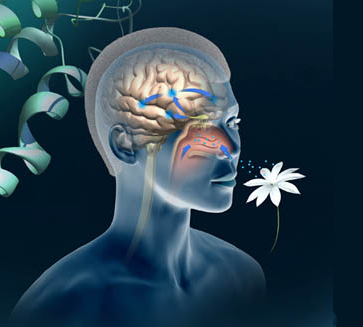| Description | Participants | Agenda | Summary | Products |
|---|
NIMBioS Investigative Workshop
Olfactory Modeling

Topic: Large-scale Modeling of Olfactory Processing
Meeting dates: March 2-4, 2015
Location: NIMBioS at the University of Tennessee, Knoxville
Organizers:
Sharon Crook, School of Mathematical and Statistical Sciences & School of Life Sciences, Arizona State Univ., Tempe
Brian Smith, School of Life Sciences, Arizona State Univ., Tempe
Objectives: The sense of smell is important for all animals; odors are associated with identifying and locating food, determining food quality, and identifying threats. In humans, loss of sense of smell occurs with normal aging and is associated with a loss in quality of life. A decline in the ability to detect and discriminate odors also can be a harbinger of neurodegenerative conditions such as Parkinson's disease and Alzheimer's disease. Moreover, the olfactory system is an important model system for exploring neural computation including changes in neural circuits in response to the environment and experience. The olfactory system provides specific and important advantages for understanding learning and memory, one of the most important goals in neuroscience. Recent technological advances have led to a wealth of information about how olfactory coding takes place in the mammalian nervous system, where experimental approaches range from large-scale measurement of neural activity during behavior to manipulation of activity via optogenetics. Integration of these data through comprehensive models of the neural networks involved in olfactory processing will provide a significant advance in our understanding of olfaction, including the relationship between neural activity and behavior. Our workshop goal was to review the current state of the mathematical approaches and tools for modeling olfaction. We also identified tasks for future development that will maximize the impact of individual projects, and defined areas of mutual interest and establish collaborations for large-scale modeling of this system, with a focus on incorporating realistic biophysical mechanisms for learning and memory.

Olfactory Modeling WordPress site.
Playlist of online videos![]()
 Summary Report. Participants presented short overviews of their own work and thoughts regarding: (1) experimentally observed properties that are important for large-scale modeling of the olfactory bulb, (2) the current state of modeling of this area and what is missing from these models, and (3) neuroinformatics resources that could be helpful moving forward, including databases and software tools. Group discussion over the course of the workshop gradually led to convergence to several important topics that are necessary for creating and understanding large-scale models of the olfactory system, including the characterization of odor space, learning and memory, and the role of feedback from piriform cortex on olfactory bulb dynamics. We also discussed ideas about a roadmap for moving forward with collaborative work in these areas, as well as the development of community based models.
Summary Report. Participants presented short overviews of their own work and thoughts regarding: (1) experimentally observed properties that are important for large-scale modeling of the olfactory bulb, (2) the current state of modeling of this area and what is missing from these models, and (3) neuroinformatics resources that could be helpful moving forward, including databases and software tools. Group discussion over the course of the workshop gradually led to convergence to several important topics that are necessary for creating and understanding large-scale models of the olfactory system, including the characterization of odor space, learning and memory, and the role of feedback from piriform cortex on olfactory bulb dynamics. We also discussed ideas about a roadmap for moving forward with collaborative work in these areas, as well as the development of community based models.
Products
Publications
Keller et al. 2017. Predicting human olfactory perception from chemical features of odor molecules. Science, 355(6327): 820. [Online]
Gerkin RC, Castro JB. 2015. The number of olfactory stimuli that humans can discriminate is still unknown. eLife, 4: e08127. [Online]
Presentation
Gerkin RC, Keller A, Mainland J, Ihara Y, Vosshall L, Meyer P. 2016. From Shape to Smell: Predicting odor descriptors for single molecules. 152.02, Society for Neuroscience (SFN).
Other
Gerkin RC. 2016. NeuronUnit: A package for data-driven validation of neuron and ion channel models using SciUnit.
NIMBioS Investigative Workshops focus on broad topics or a set of related topics, summarizing/synthesizing the state of the art and identifying future directions. Workshops have up to 35 participants. Organizers and key invited researchers make up half the participants; the remaining participants are filled through open application from the scientific community. Open applicants selected to attend are notified by NIMBioS within two weeks of the application deadline. Investigative Workshops have the potential for leading to one or more future Working Groups. Individuals with a strong interest in the topic, including post-docs and graduate students, are encouraged to apply. If needed, NIMBioS can provide support (travel, meals, lodging) for Workshop attendees, whether from a non-profit or for-profit organization.
A goal of NIMBioS is to enhance the cadre of researchers capable of interdisciplinary efforts across mathematics and biology. As part of this goal, NIMBioS is committed to promoting diversity in all its activities. Diversity is considered in all its aspects, social and scientific, including gender, ethnicity, scientific field, career stage, geography and type of home institution. Questions regarding diversity issues should be directed to diversity@nimbios.org. You can read more about our Diversity Plan on our NIMBioS Policies web page. The NIMBioS building is fully handicapped accessible.
NIMBioS
1122 Volunteer Blvd., Suite 106
University of Tennessee
Knoxville,
TN 37996-3410
PH: (865) 974-9334
FAX: (865) 974-9461
Contact NIMBioS


